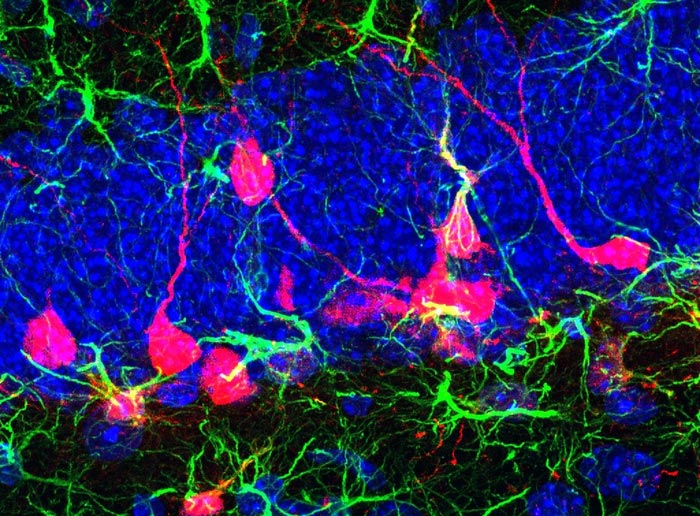Early diagnosis of neurodegenerative diseases will pass through RNA

Most studies have focused on neurons, where piRNAs are present in low amounts. On the contrary, the IIT team focused on the neural stem cells, which are the precursor cells generating neurons, where piRNAs are more abundant.
Credit: IIT-Istituto Italiano di Tecnologia
The correlation between small RNA molecules and aging-related brain diseases has been described on EMBO Reports. The study lays the groundwork for future RNA diagnostic tests for neurodegenerative diseases.
Researchers from the Neurobiology of miRNA team coordinated by Davide De Pietri Tonelli at the Istituto Italiano di Tecnologia (IIT-Italian Institute of Technology) has discovered the correlation between a class of small RNA molecules, piRNAs, and brain inflammation. The study lays the groundwork for the development of new diagnostic technologies able to early detect neurodegenerative diseases, such as Alzheimer’s and Parkinson’s. The study has been published in the journal EMBO Reports.
RNA is a fundamental molecule for the functioning of any living organism on Earth and can be categorized into several different types, according to their role. Among them, there is the Piwi-interacting RNA (piRNA), which is named after the proteins (Piwi) it interacts with. Its role is to regulate the process of cell differentiation.
piRNA molecules are present in the male reproductive organs, where they contribute to the preservation of fertility. They are also present in the brain and their alterations are connected to the development of neurodegenerative diseases. IIT researchers discovered the underlying mechanism, which was still unclear.
Most studies have focused on neurons, where piRNAs are present in low amounts. On the contrary, the IIT team focused on the neural stem cells, which are the precursor cells generating neurons, where piRNAs are more abundant. The number of distinct piRNA sequences identified in neural stem cells has been quantified at around 500,000, which are capable of regulating about 6,000 genes, some of them linked to brain inflammation, aging and regulation of circadian rhythms, often altered in neurodegenerative diseases.
IIT researchers blocked the synthesis of piRNAs and observed that neural stem cells ceased to produce new neurons, a process that occurs spontaneously during aging and that was not associated with the presence of these RNA molecules. Therefore, the work by the research group implicates for the first time piRNAs in the maintenance of healthy cognitive function and the prevention of aging-related brain diseases.
The next goal of this research will be to further analyze the piRNAs to see if they are altered in specific brain diseases, thus laying the groundwork for new diagnostic tools.
“Our work opens new avenues for the therapeutic uses of these tiny RNA molecules for the early diagnosis of age-related brain pathologies and possibly new RNA vaccines against neurodegenerative diseases such as Alzheimer’s and Parkinson’s” concludes Davide De Pietri Tonelli, coordinator of the Neurobiology of miRNA laboratory.
The study involved collaborators at the RIKEN institute of Yokohama (Japan) and at the University of Amsterdam (The Netherlands). It was partly supported by the PNRR (CENTRO NAZIONALE 3 – “Sviluppo di terapia genica e farmaci con tecnologia a RNA”). This work was conducted in the framework of the recently launched IIT’s “RNA initiative” (https://www.iit.it/web/irna), which involves 18 labs of IIT with multidisciplinary expertise.
Journal: EMBO Reports
DOI: 10.15252/embr.202153801
Method of Research: Experimental study
Subject of Research: Cells
Article Title: Piwil2 (Mili) sustains neurogenesis and prevents cellular senescence in the postnatal hippocampus
Article Publication Date: 6-Dec-2022
Media Contact
Valeria delle Cave
Istituto Italiano di Tecnologia – IIT
valeria.dellecave@iit.it
Office: 0039 010 2896
All latest news from the category: Life Sciences and Chemistry
Articles and reports from the Life Sciences and chemistry area deal with applied and basic research into modern biology, chemistry and human medicine.
Valuable information can be found on a range of life sciences fields including bacteriology, biochemistry, bionics, bioinformatics, biophysics, biotechnology, genetics, geobotany, human biology, marine biology, microbiology, molecular biology, cellular biology, zoology, bioinorganic chemistry, microchemistry and environmental chemistry.
Newest articles

How Geothermal Energy Shapes Bavaria’s Green Future Through Sustainable Energy
The Bavarian State Ministry of Science and the Arts has extended its funding for the research association “Geothermal Alliance Bavaria,” with the University of Bayreuth (UBT) continuing as a member…

Spintronics memory innovation: A new perpendicular magnetized film
Long gone are the days where all our data could fit on a two-megabyte floppy disk. In today’s information-based society, the increasing volume of information being handled demands that we…

Materials with a ‘twist’ show unexpected electronic behaviour
In the search for new materials that can enable more efficient electronics, scientists are exploring so-called 2-D materials. These are sheets of just one atom thick, that may have all…



